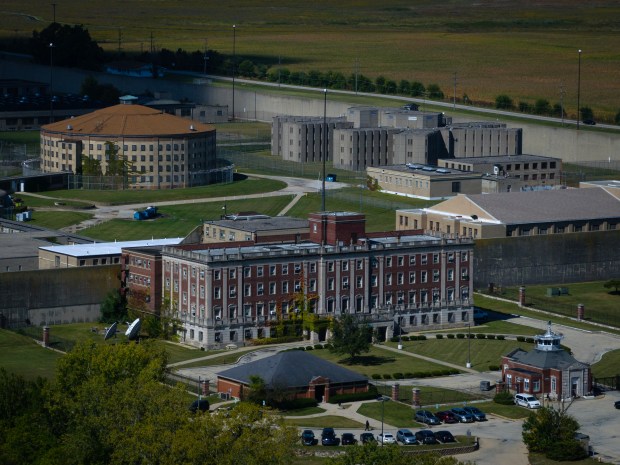Authorities quickly hustled convicted mass murderer Robert Crimo III out of the Lake County jail last week and to his new home at Stateville Correctional Center. Surely, Lake County corrections officers weren’t sad to see him pack up and go.
While the county jail has never been known for posh surroundings, it will seem like a country club compared to the aging state prison in Crest Hill in Will County, which is what the 24-year-old deserves since Illinois unfortunately doesn’t have the death penalty.
“Due to the hard work of the Circuit Clerk’s Office quickly processing all of the post-conviction paperwork, our Corrections Team was able to transfer the defendant to an Illinois prison,” Lake County Sheriff John Idleburg told one news outlet. “Our correctional officers did a terrific job getting the defendant transferred quickly, to the place he will spend the rest of his life.”
After unexpectedly pleading guilty last month to the first-degree murders of seven spectators at the July 4, 2022, parade in Highland Park and the attempted murder of 48 people wounded in the attack, he will spend the rest of his life in an Illinois Department of Corrections facility given that Stateville is scheduled to be closed. He has no chance of parole.
Lake County Circuit Court Judge Victoria Rossetti sentenced the gunman to seven consecutive natural life sentences for each victim he killed, plus 50 years for the other parade-goers he was convicted of shooting. “The court finds that the defendant is irretrievably depraved, permanently incorrigible, irreparably corrupt and beyond any rehabilitation,” the judge said at sentencing.
Nineteen victims of the shootings and their loved ones testified with emotional victim-impact statements of grief, trauma and loss from the attack, which killed or injured people ranging in age from 8 to 88. The killings devastated the Highland Park community.
Murdered along the parade route were Katherine Goldstein, 64; Irina McCarthy, 35, and her husband, Kevin McCarthy, 37; Stephen Straus, 88; Jacki Sundheim, 63; Nicolas Toledo-Zaragoza, 78; and Eduardo Uvaldo, 69. They were there on a sunny summer day to celebrate the nation’s birthday.
Crimo remained absent during the two-day sentencing hearing last week as he continued to play with authorities, and the families and friends of his victims killed when he unleashed 83 high-powered bullets from a rooftop along the Independence Day parade route.
Changing his pleas since the horrific parade shootings and even one time blaming the FBI for the murders, Crimo has failed to acknowledge the evil he accomplished at the parade by using an assault-style rifle his father enabled him to purchase, despite numerous indications that the young man should not have gotten anywhere near any firearm.
Robert Crimo Jr. sponsored his son’s state Firearm Owner’s Identification card, which allowed him to buy the AR-style weapon he used in the massacre. The father pleaded guilty to misdemeanor reckless conduct and was sentenced to 60 days in county jail in 2023.
A lawsuit against Smith & Wesson, the manufacturer of the weapon used, gun shops, and Crimo III and his father is winding its way through the judicial system. This, while survivors of those murdered will be reminded of their losses daily.
Crimo may be placed in solitary confinement for his initial stop at Stateville, a maximum-security state prison which holds some 3,500 inmates. Illinois taxpayers will pay for his stay at an estimated $32,000 a year.
The worst mass-murderer gunman in Illinois, Crimo will follow other monsters who have called Stateville home over the decades. Like John Wayne Gacy, the Norwood Park Township serial killer who murdered at least 33 young men and boys during the 1970s.
Gacy, convicted of his crimes in 1980, was executed by lethal injection at Stateville on May 10, 1994, when Illinois still had a Death Row. Richard Speck, who stabbed and strangled eight student nurses in Chicago in 1966, died of a heart attack in Stateville in 1991, just before his 50th birthday.
Other members of the Stateville rogues’ gallery include William Heirens, convicted of three murders in 1946; and Nathan Leopold and Richard Loeb, the infamous “thrill killers” of 1924 who were spared the death penalty.
Lake County State’s Attorney Eric Rinehart, whose prosecution team had insurmountable evidence that Crimo was the only suspect in the parade shootings, said the murderer laughed and made jokes during his initial police interrogation, and has never shown remorse for his actions.
Maybe that contrition will come as Crimo ages in the cage in which he will reside for the coming decades. That is, if he lives that long.
Notorious killers have a way of losing their lives at the hands of fellow inmates, like Loeb, who was killed by another Stateville prisoner; the “Boston Strangler” Albert DeSalvo, who was found stabbed to death while in a Massachusetts prison infirmary; and Milwaukee serial killer Jeffrey Dahmer, who was beaten to death while in a Wisconsin prison.
Charles Selle is a former News-Sun reporter, political editor and editor.
sellenews@gmail.com
X: @sellenews



